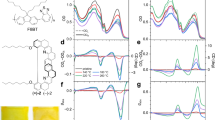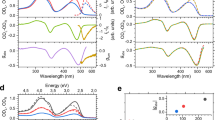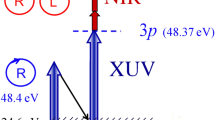Abstract
When methanol, a nonsolvent, was added to dilute tetrahydrofuran solutions of an optically active polyfluorene derivative, liquid–liquid phase separation occurred, and circular dichroism (CD) was induced at a low temperature. The polymer concentration of the minor separating phase, estimated by light scattering, was very high (∼0.4 g cm−3). The CD induction occurring in that concentrated phase was temperature sensitive. When the phase-separating solution was quenched from 40 to 15 °C, the CD increased according to first-order reaction kinetics, and it was a rather slow process (the rate constant was 2.5 × 10−4 s−1). The intermolecular chiral interaction in the concentrated phase may be responsible for the CD induction or non-racemization of this helical polyfluorene derivative in phase-separating solutions.
Similar content being viewed by others
Log in or create a free account to read this content
Gain free access to this article, as well as selected content from this journal and more on nature.com
or
References
Scherf, U. & Neher, D. (eds.) Polyfluorenes (Springer: Berlin, Heiderberg, 2008).
Grimsdale, A. C. & Müllen, K. Polyphenylene-type emissive materials: poly(para-phenylene)s, polyfluorenes, and ladder polymers. Adv. Polym. Sci. 199, 1 (2006).
Oda, M., Nothofer, H.- G., Lieser, G., Scherf, U., Meskers, S. C. J. & Neher, D. Circularly polarized electroluminescence from liquid-crystalline chiral polyfluorenes. Adv. Mater. 12, 362–365 (2000).
Oda, M., Meskers, S. C. J., Nothofer, H. G., Scherf, U. & Neher, D. Chiroptical properties of chiral-substituted polyfluorenes. Synth. Met 111–112, 575–577 (2000).
Tang, H.- Z., Fujiki, M. & Sato, T. Thermodriven conformational transition of optically active poly[2,7-{9,9-bis[(S)-2-methyloctyl]}fluorene] in solution. Macromolecules 35, 6439–6445 (2002).
Wu, L., Sato, T., Tang, H.- Z. & Fujiki, M. Conformation of a polyfluorene derivative in solution. Macromolecules 37, 6183–6188 (2004).
Wu, L. & Sato, T. Aggregation-induced circular dicroism of optically active polyfluorene derivatives in solution. Kobunshi Ronbunshu 63, 505–511 (2006).
Lieser, G., Oda, M., Miteva, T., Meisel, A., Nothofer, H.- G., Scherf, U. & Neher, D. Ordering, graphoepitaxial orientation, and conformation of a polyfluorene derivative of the ‘hairy-rod’ type on an oriented substrate of polyimide. Macromolecules 33, 4490–4495 (2000).
Hong, S. Y., Kim, D. Y., Kim, C. Y. & Hoffmann, R. Origin of the broken conjugation in m-phenylene linked conjugated polymers. Macromolecules 34, 6474–6481 (2001).
Knaapila, M. & Winokur, M. J. Structure and morphology of polyfluorenes in solutions and the solid state. Adv. Polym. Sci. 212, 227–272 (2008).
Lakhwani, G., Meskers, S. C. J. & Janssen, R. A. J. Circular differential scattering of light in films of chiral polyfluorene. J. Phys. Chem. B 111, 5124–5131 (2007).
Langeveld-Voss, B. M. W., Waterval, R. J. M., Janssen, R. A. J. & Meijer, E. W. Principles of ‘majority rules’ and ‘sergeants and soldiers’ applied to the aggregation of optically active polythiophenes: evidence for a multichain phenomenon. Macromolecules 32, 227–230 (1999).
Nakashima, H., Fujiki, M., Koe, J. R. & Motonaga, M. Solvent and temperature effects on the chiral aggregation of poly(alkylarylsilane)s bearing remote chiral groups. J. Am. Chem. Soc. 123, 1963–1969 (2001).
Goto, H. & Yashima, Y. Electron-induced switching of the supramolecular chirality of optically active polythiophene aggregates. J. Am. Chem. Soc. 124, 7943–7949 (2002).
Peng, W., Motonaga, M. & Koe, J. R. Chirality control in optically active polysilane aggregates. J. Am. Chem. Soc. 126, 13822–13826 (2004).
Yamakawa, H. Modern Theory of Polymer Solutions Rice S.A. (ed). (Harper & Row: New York, 1971).
Strazielle, C. in Light Scattering from Polymer Solutions Huglin M.B. (ed). (Academic Press: London & New York, 1972).
Flory, P. J. Principles of Polymer Chemistry (Cornell University Press: Ithaca, New York, 1953).
Dias, F. B., Morgado, J., Maçanita, A. L., da Costa, F. P., Burrows, H. D. & Monkman, A. P. Kinetics and thermodynamics of poly(9,9-dioctylfluorene) β-phase formation in dilute solution. Macromolecules 39, 5854–5864 (2006).
Sato, T., Terao, K., Teramoto, A. & Fujiki, M. Molecular properties of helical polysilylenes in solution. Polymer 44, 5477–5495 (2003).
Wesslau, H. Die molekulargewichtsverteilung einiger niederdruckpolyäthylene. Makromol. Chem. 20, 111–120 (1956).
Brandrup, J. & Immergut, E. H. (eds). Polymer Handbook 3rd edn. (John Wiley & Sons: New York, 1989).
Prod, G. In: Small Angle X-ray Scattering Glatter O., Kratky O.(eds). (Academic Press: London, 1982).
Debye, P. Light scattering in soap solutions. Ann. N.Y. Acad. Sci. 51, 575–592 (1949).
McLachlan, A. D. Retarded dispersion forces between molecules. Proc. Roy. Soc. London A271, 387–401 (1963).
McLachlan, A. D. Retarded dispersion forces in dielectrics at finite temperatures. Proc. Roy. Soc. London A274, 80–90 (1963).
Imura, H. & Okano, K. van der Waals–Lifshitz forces between anisotropic ellipsoidal particles. J. Chem. Phys. 58, 2763–2776 (1973).
Israelachvili, J. N. Intermolecular and Surface Forces 2nd edn. (Academic Press: London, 1992).
Osipov, M. A. Theory for cholesteric ordering in lyotropic liquid crystals. Il. Nuovo Cimento D 10, 1249–1262 (1988).
Osipov, M. A. Molecular theory of solvent effect on cholesteric ordering in lyotropic polypeptide liquid crystals. Chem. Phys. 96, 259–270 (1985).
Osipov, M. A. in Liquid Crystalline and Mesomorphic Polymers Shibaev V.P., Lam L. (eds). (Springer: Berlin & Heidelberg, 1994), Chapter 1.
Lifson, S., Andreola, C., Peterson, N. C. & Green, M. M. Macromolecular stereochemistry: helical sense preference in optically active polyisocyanates. Amplification of a conformational equilibrium deuterium isotope effect. J. Am. Chem. Soc. 111, 8850–8858 (1989).
Morino, K., Maeda, K., Okamoto, Y., Yashima, E. & Sato, T. Temperature dependence of helical structures of poly(phenylacetylene) derivatives bearing an optically active substituent. Chem. Eur. J. 8, 5112–5120 (2002).
Acknowledgements
This work was partly supported by a Grant-in-Aid for Scientific Research on Priority Area ‘Soft Matter Physics.’ One of the authors (Y Sanada) expresses his special thanks for the global center of excellence program, ‘Global Education and Research Center for Bio-Environmental Chemistry,’ of Osaka University.
Author information
Authors and Affiliations
Corresponding author
Rights and permissions
About this article
Cite this article
Sanada, Y., Sato, T. Induced circular dichroism of an optically active polyfluorene derivative in phase-separating solutions. Polym J 42, 195–200 (2010). https://doi.org/10.1038/pj.2009.330
Received:
Revised:
Accepted:
Published:
Issue date:
DOI: https://doi.org/10.1038/pj.2009.330



